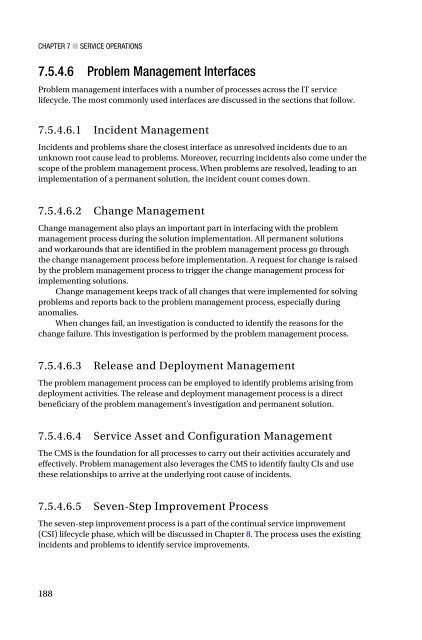become-itil-foundation-certified-abhinav-kaiser(www.ebook-dl.com)
You also want an ePaper? Increase the reach of your titles
YUMPU automatically turns print PDFs into web optimized ePapers that Google loves.
Chapter 7 ■ Service Operations<br />
7.5.4.6 Problem Management Interfaces<br />
Problem management interfaces with a number of processes across the IT service<br />
lifecycle. The most <strong>com</strong>monly used interfaces are discussed in the sections that follow.<br />
7.5.4.6.1 Incident Management<br />
Incidents and problems share the closest interface as unresolved incidents due to an<br />
unknown root cause lead to problems. Moreover, recurring incidents also <strong>com</strong>e under the<br />
scope of the problem management process. When problems are resolved, leading to an<br />
implementation of a permanent solution, the incident count <strong>com</strong>es down.<br />
7.5.4.6.2 Change Management<br />
Change management also plays an important part in interfacing with the problem<br />
management process during the solution implementation. All permanent solutions<br />
and workarounds that are identified in the problem management process go through<br />
the change management process before implementation. A request for change is raised<br />
by the problem management process to trigger the change management process for<br />
implementing solutions.<br />
Change management keeps track of all changes that were implemented for solving<br />
problems and reports back to the problem management process, especially during<br />
anomalies.<br />
When changes fail, an investigation is conducted to identify the reasons for the<br />
change failure. This investigation is performed by the problem management process.<br />
7.5.4.6.3 Release and Deployment Management<br />
The problem management process can be employed to identify problems arising from<br />
deployment activities. The release and deployment management process is a direct<br />
beneficiary of the problem management’s investigation and permanent solution.<br />
7.5.4.6.4 Service Asset and Configuration Management<br />
The CMS is the <strong>foundation</strong> for all processes to carry out their activities accurately and<br />
effectively. Problem management also leverages the CMS to identify faulty CIs and use<br />
these relationships to arrive at the underlying root cause of incidents.<br />
7.5.4.6.5 Seven-Step Improvement Process<br />
The seven-step improvement process is a part of the continual service improvement<br />
(CSI) lifecycle phase, which will be discussed in Chapter 8. The process uses the existing<br />
incidents and problems to identify service improvements.<br />
188


